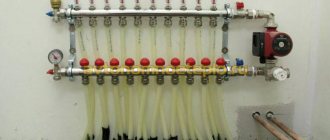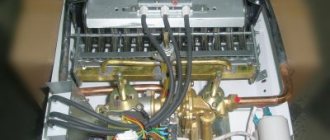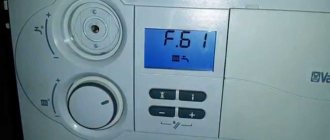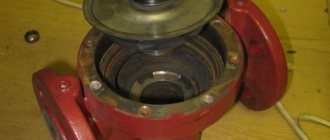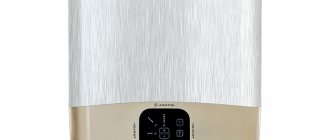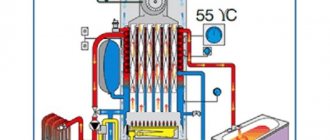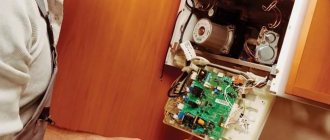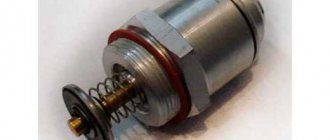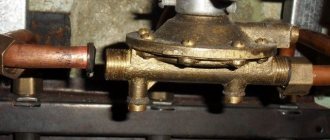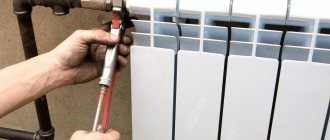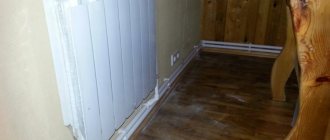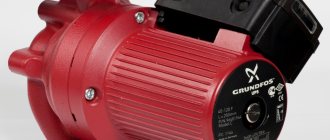Main types of breakdowns of Grundfos pumps
If you know how to handle equipment and have an understanding of the technical structure of water pressure equipment, you can repair the pump yourself.
To do this, you will need to correctly determine the cause of the breakdown and choose a method to eliminate it. Pumping equipment almost always breaks down suddenly, without any special warning signs.
All pumps, regardless of their technical characteristics or operating principle, are most often susceptible to the following malfunctions:
- There is no torque on the moving parts of the equipment.
- Spontaneous shutdown of the device.
- High levels of noise or vibration.
- Low water pressure.
If the device hums, but does not spin, then there is a high probability of oxidation of the rotating shaft, or calcification of the rotating parts. This is possible as a result of long-term downtime of internal mechanisms. When the device not only does not spin, but also does not hum, most likely the problem is in the power supply to the motor. Spontaneous shutdown of pumping equipment indicates the presence of mineral deposits between the starter and rotor.
Loud noise during operation is usually caused by air leaks into the water supply pipes due to depressurization of the unit. Vibration indicates faulty bearings on the rotating components of the pump. A drop in pressure is usually caused by clogged filters, or by improper connection of the device to a three-phase power source.
How can you eliminate typical circulation pump malfunctions?
There are a number of typical faults in circulation pumping devices that you can fix yourself. Each block will describe the symptoms of a malfunction, its causes and steps to do it yourself.
The pump is humming, there is no rotation
The cause may be oxidation of the motor shaft during prolonged inactivity of the pump. Troubleshooting instructions.
- Turn off the power to the equipment.
- We remove water from the pump and pipelines adjacent to it.
- Remove the screws securing the housing and the electric motor.
- We dismantle the electric motor complete with rotor.
- We turn the rotor by hand or with a screwdriver, resting against the working notch.
The next reason for such a malfunction may be the ingress of foreign objects.
- Turn off the power to the equipment.
- We remove water from the pump and pipelines.
- Remove the screws securing the housing and the electric motor.
- We remove the foreign object.
- We protect the pump inlet pipe with a strainer.
The lack of rotation can also be caused by a lack of power supply. To do this, we use a tester to check the presence of power at the terminals in the box and the correct connection of the electrical wires.
The pump does not hum or rotate
The main cause of such a malfunction may be a lack of power supply or insufficient voltage in the network. To eliminate it, you need to use a tester to check the voltage at the terminals and, if necessary, whether the device is connected correctly to the power supply.
Many electric pumps are equipped with a fuse. During power surges, it burns out and requires replacement.
The pump starts working, but stops after a while
The cause of this malfunction may be the deposition of limescale between the stator and the rotating rotor. The malfunction can be eliminated by dismantling the electric motor and cleaning it of limestone deposits.
The pump makes a lot of noise when turned on
The cause of this malfunction may be the presence of air in the heating system pipeline. To eliminate it, you need to bleed the air from the pipes. To automatically release air, it is recommended to install an automatic unit in the upper segment of the pipeline.
If a sharp noise is accompanied by increased vibration, it is recommended to increase the pressure at the inlet to the pumping device. Insufficient pressure can be compensated by increasing the coolant level in the system.
The pump vibrates a lot
The cause of such a malfunction is usually severe wear of the bearing that ensures the rotation of the impeller. The malfunction is eliminated by replacing the worn bearing.
What to do if the pump produces insufficient pressure?
The cause of such a defect may be the wrong direction of rotation of the wheel with blades. The cause of this phenomenon is usually an incorrectly connected phase when connecting three-phase equipment.
Also, a decrease in pressure can be caused by increased viscosity of the coolant, then the impeller encounters too much resistance. To eliminate it, it is necessary to clean the filter on the inlet pipe from deposits, check the cross-section of the incoming pipeline and set the necessary pump adjustment parameters.
What to do if the pump stops after starting?
Most likely, the cause of such a malfunction may be incorrect connection of the wires according to the phases in the terminal box. The fuse on your pump may not be tight enough. Remove it and clean the clamps.
How to disassemble Grundfos
When you are absolutely sure that the cause of the problem is some internal problem in the mechanism, you should begin disassembling the pump.
Before this, it should be disconnected from the power supply and the water should be drained from the internal cavities and tubes. You should start disassembling the device from the junction box, after which a visual inspection of the internal components is carried out. In this way, you can find a burnt or failed part. In a situation where all the components in this part of the device are in working order, you should continue disassembling.
Grundfos deep-well pumps are disassembled as follows:
- The body is firmly clamped in a vice. This is best done using two halves of a steel pipe of the appropriate diameter. This eliminates the possibility of deformation of the device body.
- If you cannot unscrew the lid by hand, the threaded seam should be lubricated with a special liquid. Often, silt and dirt accumulate at the junction of the cover and the body itself, making it difficult to turn the thread.
- After removing the cover, remove the rotor from the working chamber.
When disassembling, the pump motor must be in a vertical position. In this case, the leakage of lubricating oil from it can be avoided.
How to carry out regular pump maintenance?
From time to time, preferably at least once a month, it is necessary to carry out an external inspection and check the quality operation of your circulation pump device.
Pump design option
- Turn on the pump and in operating mode, check for any extraneous noise or excessive vibration.
- Check the coolant pressure supplied by the pump. It must correspond to the indicators stated in the technical data sheet.
- Make sure that the electric motor of the device does not become overheated.
- Check the presence of grease on the threaded flanges and, if necessary, restore it.
- Make sure there is a ground connection between the pump housing and the appropriate terminal.
- Inspect the pump from all sides and make sure there are no leaks. Typically, such vulnerable points are the interface between the pipeline and the housing of the pumping device. Check the tightening level of the bolts and the normal condition of the gaskets.
- Inspect the terminal box. All wires must be securely fixed. The presence of moisture in the unit is unacceptable.
Grundfos repair
To diagnose the engine, you will need an ohmmeter.
When you rotate the handle of this device, it produces a voltage of about 200V. If the ohmmeter readings are extremely high, tending to plus infinity, then there is a break in the working phase. If the resistance values are very small, then we can confidently talk about a short circuit between the turns of the electric motor. It is impossible to carry out high-quality engine repairs with such problems at home, and it should be taken to a specialized workshop.
If everything is in order with the engine and electrical equipment, the cause of the malfunction may be mechanical breakdowns, or clogging of the internal working spaces with debris, silt, or mineral deposits. In this situation, the insides of the pump are washed in running water and thoroughly cleaned with a brush. Particular attention should be paid to bearings, water supply wheel, and valves. O-rings and seals must be in good condition, elastic and without mechanical damage.
After cleaning the parts and components, you can reassemble the device and try to start it up again. At the same time, do not forget to fill the working chambers of the device with water. Running it “dry” will certainly lead to an even more serious breakdown, after which it will be necessary to repair the pumping station at a service center.
It is important!
Interesting fact : in 50% of cases, repair of pumps and pumping stations is required due to the fault of craftsmen who performed the installation incorrectly. In another 40% of cases, the breakdown occurs due to the fault of the user himself. Yes, most customers do not follow simple operating rules.
They ignore all our words and then ask why the equipment breaks down so often. Well, if they don’t want to, let them do whatever they want – it’s their own business.
And only in 10% of cases are pumps repaired because they simply have reached their deadline. About once a year you need to do preventive maintenance (i.e., carry out diagnostics and eliminate detected faults) and then everything will be fine. If the equipment breaks down ahead of schedule, then you can count on warranty repairs of water pumps.
Based on these statistics, two simple conclusions :
- Be more careful when choosing craftsmen who will install the equipment.
- Follow the operating instructions.
If you want to save on repairs, or even forget about it for many years, order installation from our company. More details about this can be found on the page “Installation and installation of well pumps”.
Grundfos service
To avoid the above problems, you should follow the operating rules of pumping equipment, as well as perform timely maintenance. Installation of Grundfos deep-well equipment and trial operation are best left to professionals. Before starting pumping stations, you should always make sure that there is water in them to avoid dry starting.
If you use the pump only in the summer season, then the rest of the time it should still be turned on, at least for half an hour every 3-4 weeks. This will avoid problems with oxidation of its internal parts. With Grundfos drainage pumps, special attention should be paid to the permeability of pipes and pipes. Since such equipment operates in particularly difficult conditions, which entail the risk of clogging, it is necessary to clean it from time to time with a strong stream of water.
Price list for equipment services
| Site visit | Price, rub.) | ||
| Moscow within the Moscow Ring Road | 4500,00 | ||
| To the city and region up to 50 km from the Moscow Ring Road | 5500,00 | ||
| To the area up to 70 km from the Moscow Ring Road | 6000,00 | ||
| up to 100 km from MKAD | 7500,00 | ||
| up to 200 km from MKAD | 8500,00 | ||
| For every subsequent 50 km from the Moscow Ring Road | 1200,00 |
* Departure to the site includes the travel time of two specialists * The minimum paid time of specialists on site is 2 hours * When leaving, household equipment is paid as industrial equipment up to 4.0 kW.
Diagnostics of Grundfos pumping equipment
Urgent diagnostics in the service - cost increase factor 1.5 Diagnostics in the service of E-pumps (with frequency drive) - coefficient. price increase 1.8
| Types of pumping equipment | Unit change | Price (RUB) at the service center | Price (RUB) on site |
| On-site pump diagnostics | 1hour/work | — | from 4400.00 |
| Household pumps - diagnostics | |||
| UPS, Alpha, UP, Comfort, Solar | 1 PC | 900,00 | from 4400.00 |
| JP, MQ, Scala, SQ, SQE, KP | 1 PC | 1200,00 | from 4400.00 |
| Sololift, AP, SB, SBA, SPO, SP-A | 1 PC | 1400,00 | from 4400.00 |
| Industrial pumps - diagnostics | |||
| CM, CH, NB, TP, LP up to 4 kW | 1 PC | 2400,00 | from 4400.00 |
| CM, CH, NB, TP, LP up to 11 kW | 1 PC | 2900,00 | from 5200.00 |
| CR, CRN, MTR, CRT, SP up to 4 kW | 1 PC | 3600,00 | from 4400.00 |
| CR, CRN, MTR, CRT, SP up to 11 kW | 1 PC | 3900,00 | from 5200.00 |
| UPS 200, MAGNA 1.3 | 1 PC | 2100,00 | from 4400.00 |
| SEG, SEV, SL, DP up to 4 kW | 1 PC | 3300,00 | from 5400.00 |
| SEV, SL, DP up to 11 kW | 1 PC | 5500,00 | from 6600.00 |
| SL, SE, SV, S up to 30 kW | 1 PC | 12600,00 | from 7900.00 |
| SPS diagnostics (without disassembling the pump unit) | 1hour/work | — | from 8200.00 |
| M/MD Station Diagnostics | 1 PC | — | 12400,00 |
Repair of Grundfos pumping equipment
| Pressure boosting and circulation pumps Grundfos | Unit change | Price (RUB) at the service center | Price (RUB) on site |
| Domestic pumps | |||
| UPS, Alpha, UP, Comfort, Solar | 1 PC | 900,00 | from 4400.00 |
| JP, MQ, Scala, SQ, SQE, KP | 1 PC | 1800,00 | from 4400.00 |
| Sololift, AP, SB, SBA, SPO, SP-A | 1 PC | 2200,00 | from 4400.00 |
| Industrial pumps | |||
| UPS 200, MAGNA 1.3 | 1hour/work | 2100,00 | from 4400.00 |
| CM, CH, NB, TP, LP,CR, CRN, MTR, CRT, SP up to 4 kW | 1hour/work | 2400,00 | from 4400.00 |
| CM, CH, NB, TP, LP,CR, CRN, MTR, CRT, SP up to 11 kW | 1hour/work | 3100,00 | from 5200.00 |
| pumps up to 22 kW | 1hour/work | — | from 6400.00 |
| pumps up to 45 kW | 1hour/work | — | from 7600.00 |
| pumps over 45 kW | 1hour/work | — | on request |
| Sewage pumps Grundfos | Unit change | Price (RUB) at the service center | Price (RUB) on site |
| SEG, SEV, SL, DP up to 4 kW | 1hour/work | 3400,00 | from 5400.00 |
| SEV, SL, DP up to 11 kW | 1hour/work | 5500,00 | from 6600.00 |
| SL, SE, SV, S up to 30 kW | 1hour/work | 7600,00 | from 7900.00 |
| M/MD | 1hour/work | — | from 7100.00 |
| Diagnostics and service work, electronic parts | Unit change | Price (RUB) at the service center | Price (RUB) on site |
| Household automation and control room without controller | 1hour/work | 2100,00 | from 4400.00 |
| Control cabinet with controller | 1hour/work | 5200,00 | on request |
| Frequency converter | 1hour/work | 4100,00 | on request |
| Industrial pump | 1 PC | — | 15000,00 |
Laser alignment of pump shafts and other equipment
| pump up to 11 kW | 1 PC | — | from 17000 |
| pump up to 37 kW | 1 PC | — | from 19000 |
| pump up to 160 kW | 1 PC | — | from 31000 |
| pump up to 200 kW | 1 PC | — | from 45000 |
| pump over 200 kW | 1 PC | — | on request |
DIY pumping station repair
To resume the work of the NS, you must do the following:
Suction line
Do-it-yourself check valve repair usually involves removing dirt or long-fiber debris that is preventing the valve from closing. For more complex breakdowns, the part is replaced.
If cracks appear on the reinforced hose through which the pump sucks air, they must be sealed with reinforced tape for repairing pipelines.
Pump
A worn housing or impeller will need to be replaced.
There are models in which a stainless steel liner is installed into the cavity. It is much cheaper to replace it than the entire body.
Cleaning the contact group and connecting pipe from dirt usually does not cause any difficulties for users.
By the way, it is best to remove plaque from contacts with a soft school eraser.
The relay is adjusted by rotating two nuts screwed onto the rods with springs on them.
The value of the switch-on pressure (also called lower) depends on the degree of compression of the large spring, and the small one regulates the difference between it and the switch-off pressure (upper). Please note, not the cut-off pressure itself, but the difference between the upper and lower pressures.
If the pump, due to wear, cannot develop sufficient pressure to shut down, you need to wait until the pressure gauge needle freezes at the maximum mark, and then manually turn off the power to the unit. Next, gradually loosen the small spring nut until the contacts click.
Types of pumping stations
NS may differ in various ways:
- Pump type: depending on the depth of the source, self-priming pumps (up to 8 m) and submersible ones are used. By type of pumping mechanism, most are of the centrifugal type, but among submersible models there are often vibration ones.
- Type of automation: if water flow is carried out exclusively in a continuous mode, for example, for irrigation, instead of a pressure switch, a flow sensor is installed on the pump. It turns on the pump when water is drawn (it reacts to the movement of the medium in the pipe) and turns off when it ends. A hydraulic accumulator is not used in such a PS. Some NS models with flow sensors and without a storage tank can also be used in regular home plumbing. They are equipped with advanced automation, which “can” smoothly start/stop the pump engine and change its power. If such functions are available, frequent switching on will not be a problem for the unit.
- Hydraulic accumulator type.
Pumping station working
Two types of hydraulic accumulators are used in PS:
- balloon: water is pumped into a rubber “bulb”;
- membrane: volumes for air and water are separated by an elastic membrane.
Also, drives may differ in capacity. It should be taken into account that the specification indicates the volume of the entire tank, and not the water tank in it.
Autonomous water supply in the house is an important component of comfortable living. Well or borehole - which is better for a country house or cottage? We'll help you figure it out.
You can familiarize yourself with the operating principle of a bio-toilet for a summer residence here.
For tips on making a vacuum press with your own hands, read this publication.
How to prepare circulation pumps for the winter heating season
In order for your heating pump to operate smoothly throughout the cold season, routine maintenance must be carried out before the start of the heating season.
- Check that the pump is connected correctly to the heating piping network. Pumping equipment must be installed in a place in the irrigation network where there is minimal possibility of air pockets forming. It is rational to place it on the return line, in front of the heating boiler.
- Before starting operation, make sure that all connecting elements of the network have maintained their tightness. To prevent the gasket from drying out, the inlet and outlet pipes are coated with a preservative lubricant during breaks in operation.
- Check the condition of the filter in front of the pump inlet. Replace or clean it if necessary.
- Check that the device is properly connected to the power supply. Not only the density of the contacts on the terminal box and the serviceability of the fuse are checked, but also the correct connection of the phases and the operating voltage in the network. The best way to check these characteristics is with a tester.
- Before starting to operate the heating circulation pump, be sure to carry out a test run, which should confirm the complete tightness of the system and the serviceability of all its components and equipment.
Pump elements
- a body having a cylindrical shape. Various metals are used for its manufacture: brass, bronze, stainless steel, cast iron. The first three have proven themselves to be excellent for use in any water supply system: they do not rust, hardly clog and last a long time. Cast iron, although it has excellent characteristics, is not very suitable for a heating system, since it is too sensitive to temperature changes - they can cause it to crack. Take this point into account when purchasing a pump, then repair work can be carried out much less frequently;
- electric motor with rotor. This element is located inside the housing. The motor power depends on which pump model you purchased. It must meet the technical requirements of the heating system in your home;
- impeller with blades. It is due to its rotation that the coolant current is stimulated. The wheel with blades is located on the rotor and is made of either stainless steel or super-strong polymers.
For this reason, circulation pumps with a dry rotor are installed only if the heating boiler is located in a separate room, which is located at a distance from living rooms. Otherwise, the constant loud hum will simply keep you and your household from sleeping.
The “wet” rotor does not have this problem; it operates quite quietly, so it can be installed in the system even if a separate boiler room is not provided to accommodate its key elements. In accordance with the name, this type of device is not “hidden” in a separate block, but is located directly in the coolant.
The disadvantage of a “wet” rotor is its lower efficiency than that of a “dry” one. Accordingly, during operation it consumes more electricity. But this is not too high a price to pay for the opportunity to sleep peacefully at night.
Finally, let's look at how a circulation pump works in general. It's simple. The wheel with blades rotates due to the switched on electric motor. The liquid flowing through the equipment is spread over the walls of the cylindrical body, and from there, under the influence of centrifugal force, it goes into the pipeline through the outlet pipe.
At the same time, the pressure decreases sharply, due to which the next portion of the coolant arrives. Thus, the equipment operates constantly and continuously.
Cleaning parts
The first step is to remove all excess deposits from the shaft and rotor.
Since the main cause of pump failure is the deposition of contaminants, the purpose of repair is usually to clean the machine. To do this, you need to remove all excess deposits from two components - the shaft and the rotor. This can be done by first unscrewing the pump screws using a hex wrench and thereby disassembling the threaded connection that holds the motor and pump. After opening it, determine how much rust has accumulated in it.
Depending on this, it can be removed using a cloth or a scraper. In order to disassemble the washer, as well as the rotor with its impeller, it is enough to insert a thin screwdriver into the grooves that are located around the support washer. You can determine for yourself how high the likelihood of new deposits forming on a given surface is. If it is smooth, then there is much less chance of deposits forming. Now it can be processed with a grinding wheel.
After this, you need to inspect the stator. As a result of work, it can oxidize quite strongly, and in this case it can only be cleaned with a hammer.
Causes and troubleshooting
- the pump turns on, but the rotor does not work. If the main element of the circulation equipment refuses to rotate, then the most obvious reason is a problem with the power supply. For example, if power surges frequently occur in the network, the fuse in the pump begins to melt, thereby breaking the electrical circuit. The solution to the problem in this case consists of two steps. First, get your network working. Secondly, replace the fuse with a new one. If everything is fine with it initially, then carefully inspect the remaining elements responsible for receiving power to the device. If damage is found to the wire or switch, they should also be replaced. It is strictly forbidden to use them if they are broken, as this can lead to complete breakdown of the equipment and harm to the health of the owners. Another point that should be checked is the condition of the electric motor winding. What is important here is the resistance indicator, which is measured using a multimeter. For some rotor models it should be from 10 to 15 ohms, for others - from 35 to 40 ohms. This depends on the specific equipment. The resistance inherent in a normally operating winding is usually indicated in the technical documentation supplied with the device. If, when tested, the multimeter displays infinity or something near zero, then this means that the winding is faulty and this element will have to be replaced;
- the pump overheats. Normally, the temperatures of this device and the pipe should match. If you find that the pump is significantly hotter than necessary, there could be several reasons for this. The first of them is incorrect installation. In this case, you will observe overheating as soon as you install the new pump. The only way to fix this is to disassemble everything again and reassemble it the way it should be. The second reason may be that the device is clogged. Most often, this is typical for heating systems that use elements susceptible to corrosive processes - for example, low-quality steel pipes. Particles of rust that form on the inner walls sometimes fall off, and the coolant carries them wherever it goes - including to the circulation pump. If the latter becomes clogged, then it has to apply more effort to ensure normal fluid flow, hence overheating occurs. The problem is solved by cleaning the filter installed inside the device, as well as all elements of the equipment where dirt has clogged. The third possible cause of overheating is insufficient or complete absence of lubricant on the bearings. This leads to a deterioration in their performance and abrasion of the elements. The solution to the problem is obvious - you need to lubricate the parts again. And the fourth reason for overheating, which is worth mentioning, is too low voltage in the electrical network. In order for the pump to work normally, it needs 220 V. If you find that the voltage in your network is less, then it is useless to deal with the circulation equipment - adjust the power supply;
- The coolant circulates with insufficient pressure. This also indicates some kind of malfunction in the operation of the equipment. As with overheating, clogging of structural elements can play an important role here. The fix method is still the same - cleaning. Also, if your network voltage is not 220 V, but 380 V, be sure to check that the pump is connected correctly. It often happens that the electrical wire is connected to the wrong phase, hence problems with the power of the equipment.
circulation pump inspection
By the way, you can make your life much easier if you initially purchase equipment with overheating and dry-running sensors. They will monitor the state of affairs and if problems arise, immediately turn off the pump, thereby signaling you about problems. This approach will help to avoid serious repair work, because the earlier a malfunction is detected, the less damage will be caused to the equipment.
We are confident that now you can easily cope with both disassembling and repairing the circulation pump. To consolidate the information, also watch the video, the link to which is located below. Good luck!
After disassembling and cleaning the pump
After cleaning and checking all parts of the GRUNDFOS pump, carefully reassemble it in reverse order. If all the actions taken do not force the pump to turn on, then there is a possibility of failure of the motor winding or capacitor. This type of repair requires the availability of spare parts that can only be provided by a service center. In the absence of a SC, the entire pump will have to be replaced. Taking into account the fact that in Europe in general water contains less various mechanical and chemical contaminants, in our conditions the guaranteed life of the pump can be reduced by a year or two.
Main causes of malfunctions
Let's mentally walk through the NS and see what can cause malfunctions in its operation.
Suction line (for systems with self-priming pumps)
After the unit is turned off, it is held in place by a check valve installed at the beginning of the water intake pipe.
During long periods of inactivity, the pump must be refilled.
If you are looking for a self-priming pump that does not need to be primed, choose a vortex type unit. However, keep in mind that it has very low efficiency.
The lack of water in the suction line may be due to the following reasons:
- the water in the source has dropped below the intake pipe;
- the check valve is not functioning properly;
- cracks or gaps appeared in the line through which air entered it (the water column ruptured).
Symptoms
If the pump is equipped with a dry running sensor, the pump will automatically turn off. Otherwise, it will work (until the overheating protection is triggered), but no water will flow.
Pump
The following troubles can happen to the main element of the NS:
- impeller sticking: a hum is heard, but the motor does not rotate;
- the capacitor has failed: the symptoms are the same;
- due to wear of the housing and impeller, the pump cannot develop a pressure in the pipeline at which the pressure switch is activated: the unit does not turn off even with zero water flow;
- The engine is burnt out: the unit does not turn on, the smell of burnt insulation is heard.
Pumping station with built-in ejector
Pressure switch
Most often, the relay stops functioning for the following reasons:
- Dirt has accumulated on the contacts, preventing the electrical connection: the pump has stopped turning on;
- the connecting pipe is clogged: the relay stops responding to changes in pressure in the water supply;
- the springs weakened, as a result of which the boundaries of the operating pressure range “floated”.
Water pipes
Signs of a clogged pipeline depend on where the relay is installed:
- the relay is located in the house next to the hydraulic accumulator, that is, a plug has formed somewhere between it and the pump: pumping water into the hydraulic accumulator began to take longer than usual;
- the relay is installed next to the pump, that is, it is located between it and the plug: the unit operates jerkily (frequent on/off).
Removing and cleaning the sensor
For normal operation of the pump, it is necessary to polish its internal walls.
Special attention should be paid to the sensor. Dirt and rust that settle on it over time often cause Grundfos pumps to lose their performance. As a result, their work may stop altogether. Therefore, the sensor also needs to be removed and cleaned of deposits. To do this, remove the cover from the control unit and disassemble the pump housing into two halves.
To remove the sensor itself, you need to unscrew the screws using the key that comes with the pump. After unscrewing the screws, the sensor housing can be easily removed by hand. If this cannot be done due to settled dirt, it can be pryed off with a screwdriver. Since this part is made of plastic, the manufacturer himself recommends cleaning it more carefully and using less aggressive materials. To do this, you can use a regular toothbrush.
Professional repair of Grundfos well pumps
Experts carefully determine the technical condition of the equipment, the feasibility and justification of its restoration. This allows you to choose a rational and inexpensive solution. Then we disassemble the system and replace worn parts and mechanisms. Routine repair of a Grundfos pump can take several hours.
If your lifting device has problems, contact LIMISH immediately. We recommend that you first familiarize yourself with the current tariffs for eliminating typical equipment breakdowns presented in the Table. High-quality repair of a Grundfos pump will restore the source’s functionality at minimal cost. Specialists are ready to travel at your request to carry out Grundfos repairs on site.
